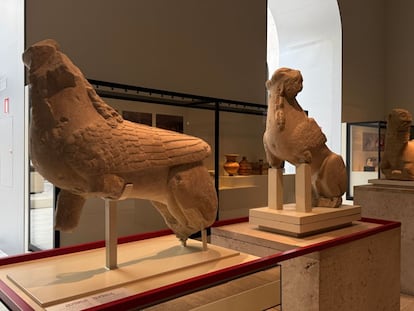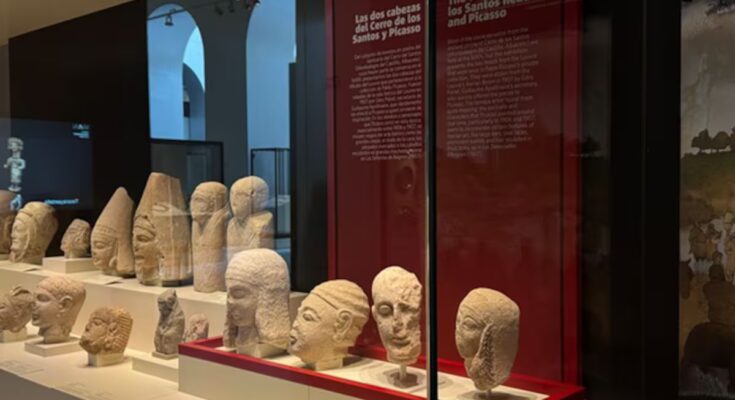In 1907, Géry Piéret, secretary of the famous French poet and playwright Guillaume Apollinaire, entered the Louvre Museum and stole an enigmatic small sandstone head that was displayed on one of the shelves of the Iberian Room of the museum institution. He gave it to Pablo Picasso, who took that figure as a model for some of his brilliant works, such as The Ladies of Avignon. What immediately fascinated the Malaga painter were the large ears of the face, the oval of the face, the marked eyelids or the hair sculpted in large locks. Picasso, perhaps repentant, returned it to the Louvre in 1911. Today, Tuesday, the exhibition was inaugurated at the National Archaeological Museum (MAN) in Madrid. Dialogues of Iberian sculpture,which brings together 10 of the magnificent pieces of Iberian art that the Louvre has preserved for more than a hundred years with its sisters Spanish. The exhibition will remain open until May 10th.
But how did the aforementioned Iberian head arrive from Cerro de los Santos, in Albacete, to the center of Paris? The story begins at the end of the nineteenth century, between the years 1891 and 1903, when the national archaeological horizon is quite similar to the Far West. Numerous French, German and Belgian specialists (Pierre Paris, Hugo Obermaier, the Siret brothers or the abbot Henri Breuil) arrive in Spain and begin to excavate the sites where the locals, or the authorities themselves, claim to have found ancient pieces (sculptures, coins, weapons or brooches). Without national legislation to protect the heritage, archaeologists – after payment agreed with the land owners or the authorities – transfer the objects to Paris, Berlin or Brussels. Among these, the Lady of Elche. They were mostly pieces of Iberian and Argaric art, unique objects that did not exist anywhere else in the world.
Therefore, of Iberian art alone, the Louvre Museum received 150 pieces. With the invasion of France by Nazi Germany, General Franco’s government reached an agreement with Hitler’s lieutenant Henrich Himmler (according to the exhibition program it was an agreement between the Spanish governments and Pétain’s puppet) according to which 36 of these Iberian works and others from different periods would return to Spain. On 21 December 1940 the 36 Iberian pieces arrived. In February 1941 they were exhibited for the first time at the Prado Museum. In 1943, the rest of the works requested by Spain arrived by rail, including the Guarrazar Treasure; that is, most of the votive crowns of the Visigothic kings, currently in the MAN.

The exhibition – curated by archaeologists Hélene le Maux, Alicia Rodero and Isabel Izquierdo – is perfectly designed to distinguish the Spanish pieces from the French ones, which is necessary because they were extracted from the same sites and some are twins.
It was the Frenchmen Arthur Engel and Pierre Paris who were the first to realize in the 19th century the existence of a culture that had been completely unknown until then, the Iberian culture. The pieces found up to that point in the center and in the Spanish highlands were assigned without distinction to Phoenician, Carthaginian or even Visigothic art. The two French experts were amazed by the beauty of the finds, which included sphinxes, hybrid beings or lions with women’s heads. They thus legally purchased emblematic sculptures of the Llano de la Consolación (Montealegre del Castillo, Albacete), the Cerro de los Santos or Osuna (Seville).

When the Spanish authorities became aware of the disaster, they tried to react. But it was too late. Although the Excavations Law was signed in 1911, the Heritage Law would not be signed until 1933. And the 1931 Constitution, in its Article 45, stated: “All the artistic wealth of the country, whoever owns it, constitutes the Cultural Treasure of the Nation and shall be under the protection of the State. The State shall also protect places notable for their natural beauty or recognized artistic or historical value.”
Now the Louvre Museum, with funding from the Ibercaja Foundation and support from the Ministry of Culture, brings to Madrid a magnificent exhibition of what the authorities of the time failed to protect more than a century ago.



